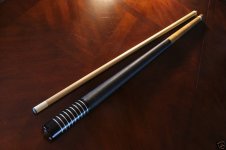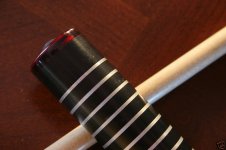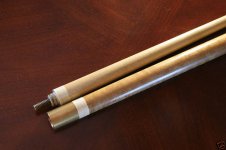I've always assumed that if the pin is coming out of the shaft it is an import cue, but did / do any custom cue makers make them that way?
You are using an out of date browser. It may not display this or other websites correctly.
You should upgrade or use an alternative browser.
You should upgrade or use an alternative browser.
Are there any decent cue where the pin is in the shaft?
- Thread starter cheapcues.com
- Start date
I have a few, but as you might imagine...they are Carom cues.
Robinson cues out of Arizona builds cues in the fashion you have described pin in the joint. Here is the link: http://www.robinsoncues.com/index.html
Burton?
There was this guy named Burton Spain who did a few like that a long time ago.
There was this guy named Burton Spain who did a few like that a long time ago.
I've always assumed that if the pin is coming out of the shaft it is an import cue, but did / do any custom cue makers make them that way?
Eddie Laube out of Chicago made them that way too.
Chris
Eddie Laube out of Chicago made them that way too.
Chris
Chris
Yeah it was a midwestern deal wasn't it? Spain, Hercek Laube and Helmstetter.
Kevin
The "Deano" sneakies have the wooden pin in the shaft.
Yeah Starkey (I think he's desi ? here on AZ) makes them that way too....Russ (poolhustler here on AZ) had one or two Starkeys and raved about them.
Here's the joint on the last unhit Helmstetter CCS I own. Helmstetter changed the 3-C world with these cues, although the one I have is a pool cue:

Thanks
Kevin
Last edited:
For snooker cues the pin in the shaft seems to be the standard.
Perhaps this is why a manufacturer of snooker cues, Dufferin, uses the same arrangement for their pool cues.
Does it make a difference?
Or is it just an American eccentricity to do the opposite?
Perhaps this is why a manufacturer of snooker cues, Dufferin, uses the same arrangement for their pool cues.
Does it make a difference?
Or is it just an American eccentricity to do the opposite?
Last edited:
I've always assumed that if the pin is coming out of the shaft it is an import cue, but did / do any custom cue makers make them that way?
Layani's conical joint is very unique and its pin comes from the shaft.
http://www.layanicues.com/sitexml/Files/main-en.html
-Ira
Hmmm
There is a Hall of Fame cuemaker, and member of MENSA, that built many cues that way, and was known to sell his world renowned full splice blanks to Balabushka. Burton unfortunatley got cancer in the early 90's, and sold his business to Joel Hercek. He then trained Joel as much as he could before he passed away at the tender age of 54. RIP Burton !!
There is a Hall of Fame cuemaker, and member of MENSA, that built many cues that way, and was known to sell his world renowned full splice blanks to Balabushka. Burton unfortunatley got cancer in the early 90's, and sold his business to Joel Hercek. He then trained Joel as much as he could before he passed away at the tender age of 54. RIP Burton !!
There have been many people over the years who have used this method for a cues pin. I don't know who was making cues this way first but, I think it was first done in Europe, in fact many European Cue Makers are still using this method today. Now I am not talking about wood screw joints used in 3-Cushion cues, I am talking about metal pins. I think Brunswick was one of the first companies making two piece cues with a metal pin in the shaft, I suspect that they started using this method around the turn of the century. In the 1920's both Herman Rambow and Harvey Martin were building cues with a metal pin in the shaft, however, both went to a pin in the cues butt around 1940. The only company I know of still building cue like this in the USA until the 1960's was Saunier Wilhem.
In the Mid-1960's Eddie Laube Patented a Brass to Brass joint which also used the Pin in the shaft construction, Eddie sold the rights to his patent and his equipment to Frank Stellman in approximately 1973 and Frank started building cues using the Name Sailor for his cues.
Also in the 1960's Burton Spain started using the Pin in the shaft method of cue construction. Now Burton used almost every configuration while he was building cues but, he preferred and mainly used this method. Burton sold his company and equipment to Joel Hercek in the early 1990's due to Burtons health problems that took his life. I am uncertain is Joel still builds cues with the Pin in the shaft, all of his cues I have seen had the Pin in the cues butt.
I have also seen a number cues over the years that had a Pin in the shaft, some were old (Before 1960) and some were more recent (After 1960) that were never identified as to who made them. When dealing with cues like this you have to evaluate them according to the quality of the construction and the materials used. While I agree that most cues like this found are junk, each still must be looked at closely you never know you may still find a diamond in the rough.
JIMO
In the Mid-1960's Eddie Laube Patented a Brass to Brass joint which also used the Pin in the shaft construction, Eddie sold the rights to his patent and his equipment to Frank Stellman in approximately 1973 and Frank started building cues using the Name Sailor for his cues.
Also in the 1960's Burton Spain started using the Pin in the shaft method of cue construction. Now Burton used almost every configuration while he was building cues but, he preferred and mainly used this method. Burton sold his company and equipment to Joel Hercek in the early 1990's due to Burtons health problems that took his life. I am uncertain is Joel still builds cues with the Pin in the shaft, all of his cues I have seen had the Pin in the cues butt.
I have also seen a number cues over the years that had a Pin in the shaft, some were old (Before 1960) and some were more recent (After 1960) that were never identified as to who made them. When dealing with cues like this you have to evaluate them according to the quality of the construction and the materials used. While I agree that most cues like this found are junk, each still must be looked at closely you never know you may still find a diamond in the rough.
JIMO
Eddie Laube out of Chicago made them that way too.
Chris
I knew Eddie, before he passed away back in the 70's, and I have one of his high end/fancy cues in near mint cond - I've had it for 40 years....for a long time I've been meaning to take some pics of it and post them up, but I keep procrastinating...maybe this thread will inspire me to take the pics and post them in this thread.
- Ghost
PS, Burton Spain was inspired and influenced by Eddie....Eddie was an excellent, and very innovative cuemaker back in the day, and imo, he and his cues have not gotten the historic recognition that they deserve.
Kobachi
Scarred but Smarter
Blonde wood
Here's one, real blond wood... :wink:
http://chicago.craigslist.org/nwi/spo/2017764200.html
Here's one, real blond wood... :wink:
http://chicago.craigslist.org/nwi/spo/2017764200.html




